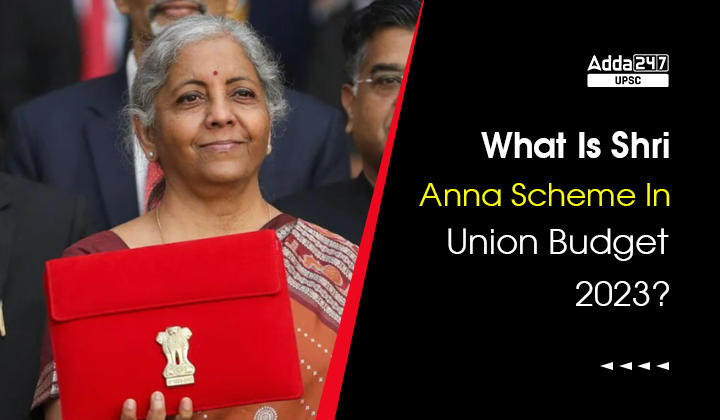Table of Contents
What Is Shree Anna Scheme In Union Budget 2023?
What is it in millets that makes it called Shri Anna or super food? And why is it beneficial for everyone? We will know all this in this article.
International Year of Millets 2023
Context Of Shree Anna Scheme
In News
- While Presenting Union Budget 2023-24, FM Nirmala Sitharaman named Millets i.e. coarse grains as Shree Anna. As, India is at the forefront of programs to popularize Shree Anna.
- FM Nirmala Sitharaman also said that Indian Millets Research Center Hyderabad will also be promotes as a center of excellence so that it can excel at the international level as well.
Background
- The UN has declared the year 2023 as the International Year of Millets.
- India Is The Largest Producer And Second Largest Exporter of Shree Anaa.
Union Budget 2023-24 on Agriculture and Farmers Welfare
What is Shree Anna?
- History: Several evidences regarding the consumption of Sri Anna during the Indus Valley Civilization suggest that it was one of the first crops to be cultivated in India.
- Grain Of Poor: It is also called the grain of the poor.
- Highly Nutritious: Millets are also very good for health. Millets not only provide protein and fiber, but also cure diseases arising in the body of the eater.
Action Plan to Promote Exports of Millets and Value-added Products of Millets
Why Shree Anna is Called a Super Food?
Shree Anna is Called a Super Food because there are more nutrients in Shree Anna.
- Along with this, these grains are rich in beta-carotene, niacin, vitamin-B6, folic acid, potassium, magnesium, zinc etc. Fiber is present in it, which improves digestion.
- In this way, the person who eats it does not have the problem of constipation.
- Consuming these strengthens the bones.
- Shri Anna is also considered best for diabetes and heart patients. For all these reasons, Shri Anna is also called superfood.
National Conference on Millets
What’s included in Shree Anna?
Jowar: It is gluten free and a good source of protein. It is a great food for diabetic patients.
Bajra: Vitamin B6, folic acid is present in it. It removes anemia.
Ragi: It is a source of natural calcium. Helps in strengthening bones of growing children and elders.
Sawa or Sama: Rich in fiber and iron. Removes acidity, constipation and anemia.
Kangni: It helps in detoxification. Controls BP and bed cholesterol.
Kodo: It is also rich in fiber. Beneficial in diseases related to goitre, rosacea and piles.
Kutki: It is a good source of antioxidants. The magnesium present in it controls healthy heart and cholesterol.
Kuttu/Buckwheat: It is beneficial for asthma patients. The amino acid present in it prevents hair loss.
Key Benefits of Shree Anna for Farmers
Easy to Cultivate
- About 80 percent of Asia’s and 20 percent of the world’s coarse grains are produced in our country. Cultivation of coarse grains is done in less cost and less water.
- Diseases are also less in this crop, due to which the use of pesticides is also negligible. Since it can be easily grown on unirrigated land, its production can be increased manifold in India if the demand increases.
More Income for Farmers
- The cultivation of Shree Anna or coarse grains requires less labor and requires less water.
- This is such a grain that can be produced without irrigation and without fertilizers.
- Only 25-30 percent of India’s total agricultural land is irrigated or semi-irrigated.
- When the demand for Shree Anna will increase, then its price will increase in the market, only then the income of poor farmers with uncultivated land will also increase.
FSSAI Calendar unveiled, celebrating International Year of Millets
How India Is Popularizing Shree Anna?
- India is playing an important role in telling and explaining the benefits of coarse grains to the world.
- The Union Government wants India to become the global center of millets. It also wants International Year of Millets 2023 to be transformed into a ‘people’s movement’.
- India is the largest producer and second largest exporter of Shree Anna. At present, most of the millet, ragi, caneri, jowar and buckwheat are exported from our country. We supply these to USA, UAE, UK, Nepal, Saudi Arabia, Yemen, Libya, Tunisia, Oman and Egypt.
- Efforts are being made to revive the forgotten glory of ‘Miracle Millets’ through the International Year of Millets (IYM) – 2023.
- The Central Government is constantly making efforts to popularize Shree Anna. Whether it is a food festival or a conclave, efforts are being made to attract foreigners and promote exports from the products made from Shree Anna.
- Whether it is lunch organized for MPs or G20 meeting in Delhi, Shree Anna dishes are being served prominently in all.



 TSPSC Group 1 Question Paper 2024, Downl...
TSPSC Group 1 Question Paper 2024, Downl...
 TSPSC Group 1 Answer key 2024 Out, Downl...
TSPSC Group 1 Answer key 2024 Out, Downl...
 UPSC Prelims 2024 Question Paper, Downlo...
UPSC Prelims 2024 Question Paper, Downlo...
